Mai - Juin
1940
The Association of Dunkirk Little Ships

A D L S

LADY OF MANN
Type: Standard Board of Trade, Ship’s Lifeboat from the 1930 Isle of Man Steam Packet ship, RMS Lady of Mann (No 8 of 10)
Length: 27ft
Beam: 8.5ft
Draft: 2.5ft
Displacement: (Dry weight) = 4.9 tons
Engine: Beat Marine 35hp 4Cylinder Diesel
Construction: Clinker – Mahogany Planking on Oak Frames (Iroko Cabin - 2017)
Builder: Vickers-Armstrong, Barrow-in-Furness
Year: 1930

HISTORY
The Lady of Mann is a Board of Trade ship’s lifeboat built in 1930. She is lifeboat No 8 (of 10), from the TSS (RMS) Lady of Mann. Her construction is of Mahogany planks on Oak frame, with the addition of an Iroko cabin.
The RMS Lady of Mann was built for the Isle of Man Steam Packet Company. She was launched in 1930, the company's Centenary year by the Duchess of Atholl, The Lady of Mann, after whom she was named. At the time of her building the ship was the largest owned by the company. The ship was built by Vickers Armstrong Ltd, at their Barrow-in-Furness yard and represented the latest development in fast home-trade passenger service. She was, essentially, an elegant ship with an unbroken and gently sheered shelter-deck, straight stem and elliptical stern, two long superstructures, and a raked and cowled funnel, which was to be the hallmark of the company’s ships. She was the first British ferry to be fitted with an Oertz rudder. Lady of Mann exceeded 22 knots on trials and her speed was often over 23 knots in service. Described as " foreman built ", she was constructed during the depression which started in 1929. Most of the builder's yard staff had been laid off and it was only the key men who had been retained that built her.
She was requisitioned as a personnel ship at the outbreak of the Second World War and because of her turn of speed, she was able to get in and out of the Dunkirk bombardments to lift 4,262 men back to England. She spent 6 hours in Dunkirk on May 31st, 1940 and despite being shelled by shore batteries and dive-bombed she emerged with little damage and a claim of one aircraft shot down. She returned to Dunkirk on the 1st June to take off 1,500 casualties and was back again on the following day but was ordered out for lack of troops although she did rescue 18 French soldiers from a small boat on the way back to England. She made her last trip to Dunkirk in the early hours of the 4th June embarking 1,244 troops in an hour from the East Pier. Operation Dynamo ended that afternoon. Twelve days later she became part of Operation Aerial to evacuate troops from Le Havre, Cherbourg and Brest, and as one of the last three ships to leave Le Havre, she steamed out under air attack carrying an estimated 5,000 on board (she was only designed to carry 2,873 passengers). From August 1940 until April 1944 she was on trooping duties between Invergordon, Aberdeen and Lerwick to the Faroes as well as acting as tender to the RMS Queen Mary ferrying allied troops from the Queen Mary in Belfast Lough to Greenock. She was one of several ships which serviced the big Cunarder. In the build-up prior to the D-Day landings she was converted to a LSI (H), Landing Ship Infantry (Hand Hoisting), carrying six landing craft, 55 officers and 435 assault troops and took part in the landings at Juno beach as the headquarters ship 512th Assault Flotilla. She retired for repairs later in the month and then returned to duties as a personnel vessel for the remainder of the war moving troops and displaced persons across the Channel. Lady of Mann was finally reconditioned and returned to Steam Packet service in May '46 after carrying an estimated 2,000,000 troops. The "Lady" returned to Douglas to be given a civic reception, proud and triumphant, on March 9, 1946 after carrying an estimated 2,000,000 troops. She returned to service after the war and continued to serve the company until 1971.
Her final passenger sailing was from Ardrossan to Douglas at 1400 on Sunday afternoon, August 14, 1971. A large crowd of onlookers had gathered on the Point of Ayer, at the northernmost tip of the Island, to witness this final homecoming of a much-loved ship. The Ramsey Coastguard station signalled the event with a display of flares, and the lighthouse keepers on Maughold Head saluted her with a mournful wailing of their fog siren. Two days later she left Douglas for the last time, witnessed by thousands on the piers and promenades of the town, as she steamed away, bound for a lay- up in Barrow. There she was put up for sale, with demolition being the most likely option for a 41-year-old steamship. She was purchased for breaking by Arnott Young of Dalmuir, Clyebank.
RMS Lady of Mann was broken up in 1971 on the Clyde, and her eighth lifeboat (of ten) was saved before being converted into a fishing boat/cabin cruiser in Maldon, Essex. It is understood that lifeboat number 8 was so chosen as she was the only lifeboat of 10 fitted with an onboard engine. During her service life she also saw considerably more action than the other lifeboats as she was always the preferred choice when carrying out exercises and real life ‘man overboard’ recovery operations. She spent the next 38 years fishing off the East Coast.
At Christmas time 2009 I came across a Marine Brokerage in Maldon, advertising this converted lifeboat for sale. Whilst still sound she was in a very dilapidated state and most potential buyers were interested in the brand-new engine on board (a 35hp Beta Marine 4-cylinder water cooled diesel engine replacing an older air-cooled Lister engine installed in her 1972 conversion), with the intention of scrapping the boat herself. Fortunately, the seller was an Isle of Man Steam Packet Enthusiast aware of her heritage and would not release her to anyone he felt wouldn't try to preserve her.
We brought her down to the Thames in Old Windsor in the summer of 2010. After a bit of remedial work on her hull, carried out by Stanley and Thomas boat builders we had several years cruising the waters around the Windsor area culminating in her involvement in the Queen’s Diamond Jubilee Pageant in 2012. She was included in the Historic Lifeboat squadron. Her last outing was to attend the 2013 Thames Traditional Boat Rally in Henley before she fell victim to the terrible floods in January and February 2014. Although we do not know the exact reason for her foundering, being an old clinker boat, she would take on water and was beholden to the automatic bilge pump at all times. During that winter on many occasions I was unable to reach her on her mooring due to the river bank flooding. It is my belief that without my being able to turn the engine over regularly and charge the battery the pump was not powered, and she was left to her fate. After much soul-searching we took the plunge and salvaged her. She was taken to Michael Dennett’s boat builders in Chertsey. It quickly became apparent that although the original hull was still sound, the cabin constructed of marine ply in 1972 was not salvageable and a complete rebuild was required. Under the expert eye and flair for design of Stephen Dennett from Dennett Boat Builder, she has been beautifully restored to a condition beyond our wildest expectation and will be ready again for the 2018 boating season. We are also delighted that she has been welcomed into the Association of Dunkirk Little Ships and the intention is to prepare her to return to Dunkirk for the first time in 80 years n 2020!
My father, Brian Cain, and I, both being 'Manxmen' have a real emotional attachment to the lifeboat we have acquired, not least because of her Isle of Man connections but also due to the fact that my Grandfather, George Cain, a fellow Manxman was rescued from the beaches of Dunkirk. Although he wasn't rescued by the 'Lady, ' (he was picked up by a Belgian fishing boat) he certainly remembered her being there and the great sense of hope and of home she gave him. The Dunkirk evacuation was perhaps the company's finest hour. Eight company ships took part in this mission, rescuing a total of 24,699 Allied troops – one in fourteen of those evacuated from Dunkirk. This was also the company's blackest day, as three of the line's ships were lost, with many Manx crewmen. To our knowledge there is no lasting representative of the Isle of Man Steam Packet Company and her vessels at Dunkirk still afloat, certainly we know that the TSS Lady of Mann of 1930 was the last vessel present at Dunkirk to survive until her demise in 1971.
Link to news article; https://boatingnz.co.nz/return-to-dunkirk/
























